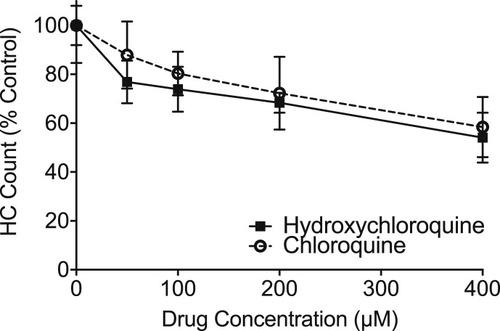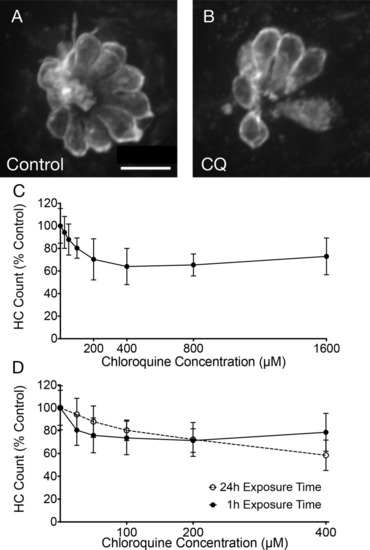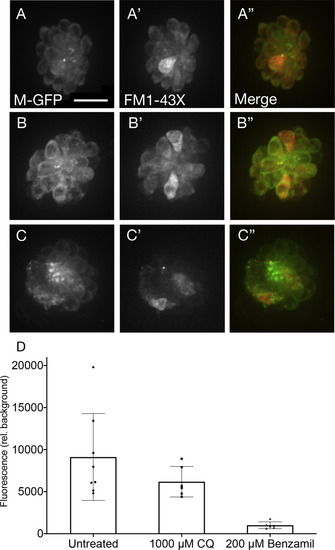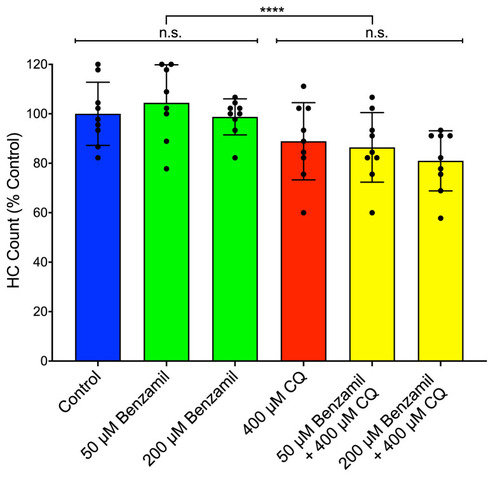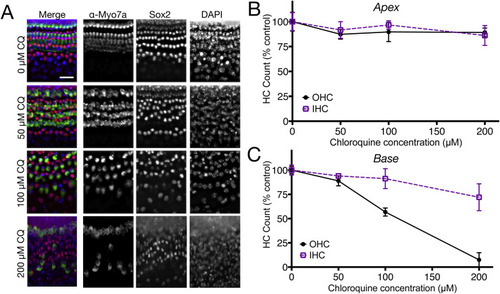- Title
-
Chloroquine kills hair cells in zebrafish lateral line and murine cochlear cultures: Implications for ototoxicity
- Authors
- Davis, S.N., Wu, P., Camci, E.D., Simon, J.A., Rubel, E.W., Raible, D.W.
- Source
- Full text @ Hear. Res.
|
Chloroquine causes dose-dependent hair cell loss in the zebrafish lateral line system. Fluorescent imaging showed robust hair cell numbers in control neuromasts (A) and reduced numbers in fish exposed to 400 μM chloroquine for 24 h (B). Hair cell counts show a decrease in hair cell viability as chloroquine concentration increased (F = 12.28, p < 0.0001; C). However, there was no significant change with concentrations from 400 μM to 1600 μM (p > 0.05). (D) This pattern was consistent between 24- and 1- hour exposure times with no statistical significance (F = 3.06, p = 0.0828). Error bars represent ±1 standard deviation. Scale bar = 10 μm. |
|
Hydroxychloroquine causes dose-dependent effects on hair cells in the zebrafish lateral line, similar to chloroquine. Dose-response functions show that hair cells exposed to hydroxychloroquine (solid line) survive at a similar rate as those exposed to chloroquine (dashed line) after a 24-h treatment period. Two-way ANOVA demonstrate a small, but significant effect, with hydroxychloroquine being slightly more toxic (F = 4.774, p = 0.03). Error bars represent ±1 standard deviation. PHENOTYPE:
|
|
Chloroquine does not reduce MET channel activity. Fluorescent imaging showed no reduction of FM1-43-X uptake with pre-exposure to chloroquine (A–C). Brn3c fish, that have green fluorescent membrane markers, had no pre-treatment (A–A”), 1000 μM chloroquine for 15 min (B–B”), or 200 μM benzamil for 15 min (C–C”). Dunn’s multiple comparisons confirmed that red fluorescence is not significantly attenuated in fish pre-treated with a high dose of chloroquine (p = 0.2334), while uptake is significantly lower in those fish treated with benzamil (p < 0.0001), a known MET channel blocker (D; n = 6–8 fish per condition). Error bars represent ±1 standard deviation. Scale bar = 10 μm. (For interpretation of the references to colour in this figure legend, the reader is referred to the Web version of this article.) |
|
Chloroquine-induced cell death is not affected by the presence of a MET channel blocker. Co-treatment of chloroquine and benzamil showed no significant change in hair cell viability, though chloroquine exposure did have a small but significant effect on hair cell survival (p < 0.0001; n = 8–9). Error bars represent ±1 standard deviation. |
|
Chloroquine exposure causes dose-dependent hair cell loss in neonatal mouse organ of Corti cultures. (A) Fluorescent imaging of basal turn cultures treated with 0, 50, 100, and 200 μM chloroquine and labeled with antibodies specific to hair cells (Myosin Vlla), or organ of Corti supporting cells (Sox2), or all nuclei (DAPI). Note that 50 μM chloroquine exposure (row labeled 50 μM CQ) did not reveal clear loss or disruption of any cell type (compare with top row (0 μM CQ). However, 100 μM and 200 μM chloroquine exposure resulted in moderate and extreme loss of outer hair cells, respectively. Conversely, there was no obvious loss of other cell types at any treatment condition. (B) Apical coil cultures demonstrate little or no loss of inner or outer hair cells following treatment with chloroquine at any of the concentrations used (p = 0.6087). (C) Basal coil hair cells, however, showed significantly decreased viability when treated with chloroquine (p < 0.0001), and outer hair cells in the base were more dramatically affected by drug exposure than inner hair cells (F = 26.11, p < 0.0001). Error bars represent ±1 standard deviation. Scale bar = 20 μm. |
Reprinted from Hearing Research, 395, Davis, S.N., Wu, P., Camci, E.D., Simon, J.A., Rubel, E.W., Raible, D.W., Chloroquine kills hair cells in zebrafish lateral line and murine cochlear cultures: Implications for ototoxicity, 108019, Copyright (2020) with permission from Elsevier. Full text @ Hear. Res.

